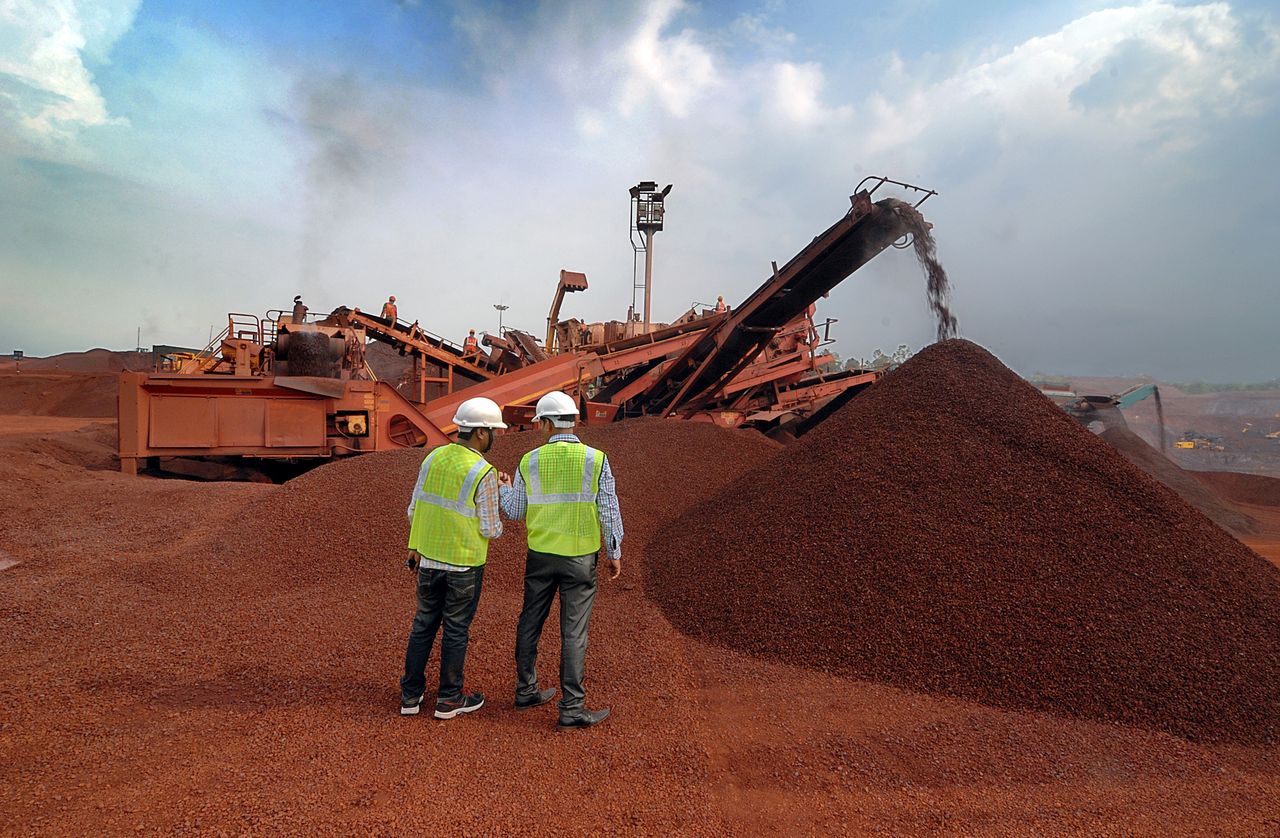China Restricts Some Steel Production
How that will weigh on iron-ore demand.
China’s efforts to drastically reduce pollution levels could lead to lower demand for iron ore, a raw material for the steel industry, which is a big source of the nation’s harmful emissions.
It hasn’t happened yet, however. “With the Chinese economy almost fully recovered from the pandemic, demand for steel is very strong,” which means that demand for iron ore is also very strong, says John Kartsonas, a managing partner at Breakwave Advisors, the advisor for the Breakwave Dry Bulk Shipping exchange-traded fund (ticker: BDRY).
At the same time, iron-ore supply remains tight, with Brazil, a major producer of the commodity, not fully recovered from a deadly accident two years ago that hurt production, he says. In 2019, Vale halted some mining operations following a fatal dam breach in Brazil, leading to significant declines in its iron-ore output. Vale pegged its production of iron-ore fines at 300.4 million metric tons in 2020, compared with nearly 384.2 million metric tons in 2018.
Tight supplies and rising demand helped lift the most-active futures contract for 62% iron-ore fines delivered to China to US$174.94 per metric ton on March 4, the highest settlement since August 2011, based on Dow Jones Market Data reports going back to October 2010. That’s not far from the record-high settlement of US$188.88 from February 2011.
China produced more than one billion metric tons of crude steel last year, and there are “no iron-ore projects that will produce sizeable net new tons for at least five years,” says Paul Bartholomew, a metals analyst at S&P Global Platts. Expectations for further Chinese economic stimulus are also positive for steel and iron-ore demand, he says.
Iron-ore prices, however, have eased in recent days on prospects of a slowdown in demand, as China plans to reduce factory activity to cut carbon emissions. The March contract was at US$168.26 on March 16, trading 2.6% lower month to date.
Tangshan, a city in China’s Hebei province referred to as the nation’s steelmaking hub, has ordered factories to limit or halt production on days when a heavy-pollution alert is in place, to cut overall emissions by 50%, according to the South China Morning Post.
“Steelmaking is a major source of pollution in China, estimated to account for about 15% of the country’s total emissions, so it is hardly surprising investors took profits at the prospect the steel industry could be facing significant environmental controls,” says Stuart Burns, editor at large for metals analysis provider MetalMiner. “The first casualty of reduced steel production would be demand for raw materials,” he says.
Still, China might not be able to fully implement restrictions on steel production. Reducing steel output may be “difficult to achieve this year,” says Bartholomew. In the past, many facilities taken offline were already “mothballed or uneconomic,” he says. “It’s harder to close production when mills are operating and making money.”
The VanEck Vectors Steel ETF (SLX), which provides exposure to companies involved in the steel sector, has climbed about 10% this month.
Given China’s restrictions on operations of some highly pollutant steel mills, however, Breakwave’s Kartsonas says he is now “a bit more cautious” on the outlook for iron-ore prices.
Brazil has signalled an increase in iron-ore production. That, in combination with China’s pollution restrictions, could lead to “more moderate” prices in the next several months, he says. Still, if demand for construction continues to support steel, that means iron-ore prices can remain “higher than historical averages for a long time.”
Reprinted by permission of Barron’s. Copyright 2021 Dow Jones & Company. Inc. All Rights Reserved Worldwide. Original date of publication: March 18, 2021
 Copyright 2020, Dow Jones & Company, Inc. All Rights Reserved Worldwide. LEARN MORE
Copyright 2020, Dow Jones & Company, Inc. All Rights Reserved Worldwide. LEARN MORE
This stylish family home combines a classic palette and finishes with a flexible floorplan
Just 55 minutes from Sydney, make this your creative getaway located in the majestic Hawkesbury region.
Continued stagflation and cost of living pressures are causing couples to think twice about starting a family, new data has revealed, with long term impacts expected
Australia is in the midst of a ‘baby recession’ with preliminary estimates showing the number of births in 2023 fell by more than four percent to the lowest level since 2006, according to KPMG. The consultancy firm says this reflects the impact of cost-of-living pressures on the feasibility of younger Australians starting a family.
KPMG estimates that 289,100 babies were born in 2023. This compares to 300,684 babies in 2022 and 309,996 in 2021, according to the Australian Bureau of Statistics (ABS). KPMG urban economist Terry Rawnsley said weak economic growth often leads to a reduced number of births. In 2023, ABS data shows gross domestic product (GDP) fell to 1.5 percent. Despite the population growing by 2.5 percent in 2023, GDP on a per capita basis went into negative territory, down one percent over the 12 months.
“Birth rates provide insight into long-term population growth as well as the current confidence of Australian families,” said Mr Rawnsley. “We haven’t seen such a sharp drop in births in Australia since the period of economic stagflation in the 1970s, which coincided with the initial widespread adoption of the contraceptive pill.”
Mr Rawnsley said many Australian couples delayed starting a family while the pandemic played out in 2020. The number of births fell from 305,832 in 2019 to 294,369 in 2020. Then in 2021, strong employment and vast amounts of stimulus money, along with high household savings due to lockdowns, gave couples better financial means to have a baby. This led to a rebound in births.
However, the re-opening of the global economy in 2022 led to soaring inflation. By the start of 2023, the Australian consumer price index (CPI) had risen to its highest level since 1990 at 7.8 percent per annum. By that stage, the Reserve Bank had already commenced an aggressive rate-hiking strategy to fight inflation and had raised the cash rate every month between May and December 2022.
Five more rate hikes during 2023 put further pressure on couples with mortgages and put the brakes on family formation. “This combination of the pandemic and rapid economic changes explains the spike and subsequent sharp decline in birth rates we have observed over the past four years,” Mr Rawnsley said.
The impact of high costs of living on couples’ decision to have a baby is highlighted in births data for the capital cities. KPMG estimates there were 60,860 births in Sydney in 2023, down 8.6 percent from 2019. There were 56,270 births in Melbourne, down 7.3 percent. In Perth, there were 25,020 births, down 6 percent, while in Brisbane there were 30,250 births, down 4.3 percent. Canberra was the only capital city where there was no fall in the number of births in 2023 compared to 2019.
“CPI growth in Canberra has been slightly subdued compared to that in other major cities, and the economic outlook has remained strong,” Mr Rawnsley said. “This means families have not been hurting as much as those in other capital cities, and in turn, we’ve seen a stabilisation of births in the ACT.”
This stylish family home combines a classic palette and finishes with a flexible floorplan
Just 55 minutes from Sydney, make this your creative getaway located in the majestic Hawkesbury region.





















